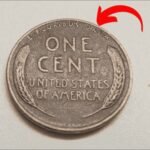Imagine picking up a penny from the sidewalk, flipping it over, and realizing it’s worth $9.6 million. Sounds like a Hollywood movie plot, right? But for a rare Lincoln Wheat Penny, this dream could be reality. This iconic coin, minted between 1909 and 1958, has captured the hearts of collectors and sparked treasure hunts across America. What makes this penny so special, and could one still be hiding in your change jar? Let’s dive into the fascinating story of the Lincoln Wheat Penny, its jaw-dropping value, and how you might spot one.
What Is the Lincoln Wheat Penny?
The Lincoln Wheat Penny, often called the “Wheat Cent,” was first minted in 1909 to celebrate the 100th anniversary of Abraham Lincoln’s birth. Designed by Victor David Brenner, it was the first U.S. coin to feature a real person’s portrait—Lincoln’s profile—replacing the symbolic Liberty figure. The reverse side showcases two wheat stalks, giving the coin its nickname. Minted until 1958, when the Lincoln Memorial design took over, billions of these pennies flooded into circulation.
Most Wheat Pennies are worth just a few cents today. But certain rare versions, thanks to minting errors or limited production, have skyrocketed in value. The $9.6 million penny? It’s tied to a legendary mistake from 1943, and experts believe some of these coins might still be out there, waiting to be found.
Why Is the 1943 Copper Penny Worth $9.6 Million?
The $9.6 million valuation comes from the 1943 Bronze Lincoln Wheat Penny, a coin so rare it’s considered the “Holy Grail” of numismatics. During World War II, copper was critical for military supplies like ammunition. To conserve it, the U.S. Mint switched to zinc-coated steel for pennies in 1943, creating the familiar “steel pennies.” But a few copper planchets (blank coins) from 1942 were accidentally left in the presses. These were struck with the 1943 design, creating an ultra-rare batch of copper pennies.
Only about 10 to 15 of these 1943 bronze pennies are known to exist, making them incredibly valuable. In 2010, one sold for $1.7 million at auction, and experts now estimate a pristine example could fetch up to $9.6 million due to rising collector demand and historical significance. The rarity, combined with the coin’s tie to World War II and Abraham Lincoln’s legacy, drives its astronomical price.
Real-Life Treasure Stories
The idea of finding a million-dollar penny isn’t just a fantasy—it’s happened before. In 2019, a Massachusetts teenager named Don Lutes Jr. discovered a 1943 bronze penny in his lunch money. Decades later, after his death, the coin was auctioned for over $200,000, with proceeds donated to a local library. Stories like this fuel excitement, proving that valuable coins can surface in everyday places—piggy banks, coin rolls, or even loose change from a coffee shop.
Another example? A 1943 copper penny was found in a cereal box in the 1980s, tucked away by someone unaware of its value. These stories remind us that treasures can hide in plain sight, making the hunt for a $9.6 million penny thrillingly possible.
How to Spot a Valuable Lincoln Wheat Penny
Think you might have a rare penny? Here’s how to check:
Check the Date and Mint Mark
The 1943 copper penny is the star, but other dates like 1909-S VDB, 1914-D, and 1955 (doubled die error) are also valuable. Look for a small mint mark under the date: “S” for San Francisco, “D” for Denver, or no mark for Philadelphia. These marks can significantly boost value.
Do the Magnet Test
Grab a magnet. Most 1943 pennies are steel and will stick, but the rare copper ones won’t. This quick test can help you spot a potential winner. A 1943 copper penny weighs about 3.11 grams, heavier than the 2.7-gram steel version.
Look for Errors
Minting errors like doubled letters or off-center strikes can increase value. The 1955 doubled die penny, for example, shows blurry text and can fetch thousands. Examine your coin with a magnifying glass for these quirks.
Check the Condition
Condition is king in coin collecting. A penny in mint or near-mint condition (graded MS-70) is worth far more than a worn one. Avoid cleaning your coin—it can damage the surface and slash its value.
Could the $9.6 Million Penny Still Be in Circulation?
Yes, it’s possible! With over 28 billion Wheat Pennies minted, many are still floating around in coin jars, old collections, or even pocket change. The 1943 copper pennies were never meant to circulate, but some slipped through. Experts estimate a few remain undiscovered, potentially sitting in a drawer or vending machine. The thrill of this possibility has collectors and everyday folks alike checking their change.
Tips for Finding Your Own Treasure
Ready to start your treasure hunt? Here are some practical tips:
- Search Coin Rolls: Buy rolls of pennies from banks and sift through them for older coins.
- Check Old Collections: Inherited coins or forgotten jars might hold surprises.
- Visit Coin Shows: Connect with dealers and experts who can evaluate your finds.
- Use a Coin Guide: Books like the Red Book (A Guide Book of United States Coins) offer detailed value estimates.
- Get It Graded: If you find a suspicious penny, take it to a professional grading service like PCGS or NGC. They’ll verify authenticity and value.
Why Collectors Are Obsessed
The Lincoln Wheat Penny’s allure goes beyond its price tag. It’s a piece of American history, tied to Lincoln’s legacy and World War II’s sacrifices. Collectors like Raju Singh, a numismatic expert, emphasize its storytelling power: “Each coin is a snapshot of its time, from the Great Depression to wartime rationing.” The combination of rarity, historical context, and the chance to strike it rich keeps the numismatic community buzzing.
A Word of Caution
Not every Wheat Penny is a jackpot. Most are worth just a few cents, and exaggerated claims (like a $4 billion penny) are often clickbait. Always verify with reputable sources like PCGS or Heritage Auctions. If you think you’ve found a rare coin, don’t rush to sell—consult an expert to avoid scams or undervaluation.
The Bottom Line
The $9.6 million Lincoln Wheat Penny is more than a coin—it’s a symbol of possibility. Whether you’re a seasoned collector or just curious, checking your change could lead to a life-changing discovery. So, next time you spot a penny, take a closer look. That humble piece of copper might just be your ticket to a fortune.



